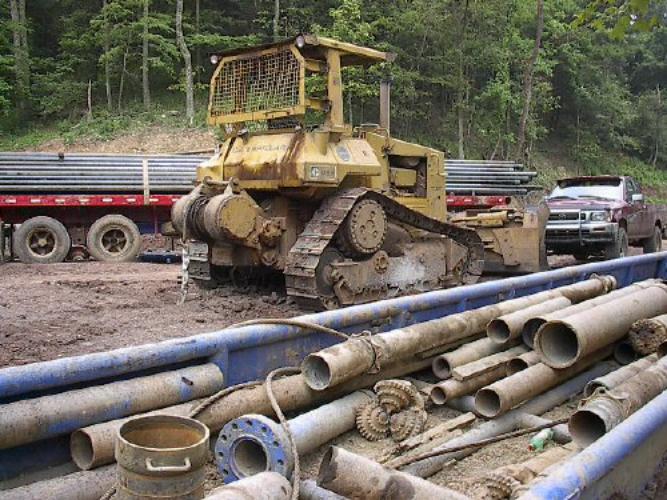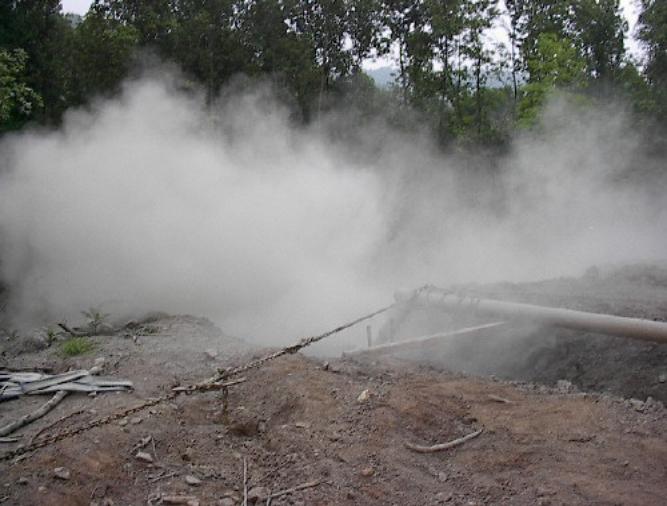
| Next Chapter | Previous Chapter | |
| Chapter 45: My Friend Jack Shock | Contents | Chapter 43: Some Generalizations |
The truth is that, in my youth, rural young people took in hatred for the gas companies with their mother’s milk. John D. Rockefeller came to West Virginia very early in the development of the oil and gas industry. He was ruthless, and much of the industry copied his highly successful methods. The leases were a form of barely legal expropriation, the environment counted for nothing, and people were less than nothing, to be used and discarded like something to wipe your nose on. His name was a
(Illustration 44-1)

Equipment on a drilling platform. Here the hole goes down about a mile.
symbol of all that was wrong with the System.
One of the nasty things about the System was that the most aggressive underlings were rewarded for what they made for the boss, without regard for what they did to other people. I remember one story that was told many times in my family. There were collecting lines that led from wells along Lost Creek (the stream) to the pump station at McWhorter. These lines had a substantial pressure on them from the gas in the ground and families there depended on the collecting lines for their gas for heating and cooking. . Someone had upset the boss at McWhorter Station, so he swore to “put a vacuum on the line and pull in every tea kettle on Lost Creek.” This threat was never actualized, but it hung in the air for years.
West Virginia law provides for the separation of various “estates” on the same land. A land owner (first party) could lease the oil and gas to a second party, meaning the second party could remove the oil and gas, paying the first party a share, called royalty. Then the first party could retain the lease rights, while the land surface with other subsurface minerals was sold to a third party. The leases invariably contained the right to remove the oil and gas, and the list of privileges reserved to the lessee (second party) was extensive, including roads, disposal of waste, even telephone lines. The lease holder (first party) got the royalty, which was based on the oil and gas removed, and the landowner (third party) got the damage to his estate, and no monetary benefit. Usually, in the early days, there was free gas for one dwelling, which came with the well, and that did stay with the landowner, since piping was so expensive, but it was up to him to lay and keep up the line to his house. In later years the oil and gas belonged to the heirs of the original lessor, and when new leases were made the free gas was forgotten. It was simply taken by the driller, who paid appropriate royalty to the mineral owner and the land owner got squeezed out. At present the land owner is paid a nominal fee for damage, but the System conspires to keep it minimum.
(Illustration 44-2)

Discharge from the drilling machine. It goes into a “pit” lined with polyethylene plastic sheet and is allowed to dry when the drilling is over, then is covered up.
Coal was also extensively separated from the surface. You can get a picture of the relations between land owner, mineral owner and mine operator in my discussion of coal on the Lost Creek Farm.
The separation of estates has been criticized extensively, but if it hadn’t been done, Northern West Virginia would be like Southern West Virginia – owned by big companies entirely. It is near enough that any way. There was a study made in 1974,by Tom Miller, a reporter for the Huntington Herald-Dispatch called “Who Owns West Virginia” which is a real eye opener. He concluded that more than two-thirds of the nonpublic land in West Virginia is owned by corporate, absentee owners. I would guess the situation now is even more extreme than it was then. Anyway, Southern West Virginia, being very steep, has little land suitable for farming. Short term West Virginia land value is in the minerals, and to a lesser, but increasing extent, the timber growing on the surface. Southern West Virginia is so completely owned by corporations, and they are so jealous of their land, that ordinary people can not even find a place to build a house.
Aside Jack Shock, mentioned in the next chapter, was the president of CLANRO (Concerned Land and Natural Resources Owners, Inc., most definitely not to be confused with anything with a K in the abbreviated title), and this author was second vice-president. This is an interesting story, because it relates to some of farming’s most intractable problems, which I will get to now.
| Next Chapter | Previous Chapter | |
| Chapter 45: My Friend Jack Shock | Contents | Chapter 43: Some Generalizations |
Copyright © 1998, 2006, 2008, 2011 S. Tom Bond (stombond at hughes.net)